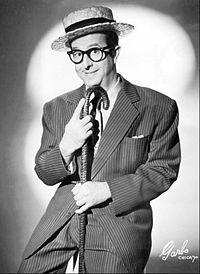Phil Silvers
| Phil Silvers | |
|---|---|

Publicity photo of Silvers
from the musical Top Banana |
|
| Birth name | Philip Silver |
| Born |
May 11, 1911 Brooklyn, New York, U.S. |
| Died | November 1, 1985 (aged 74) Century City, California, U.S. |
| Nationality | American |
| Genres | Character comedy |
| Spouse |
Jo-Carroll Dennison (m. 1945; div. 1950) Evelyn Patrick (m. 1956; div. 1966) |
| Children | 5 |
Phil Silvers (May 11, 1911 – November 1, 1985) was an American entertainer and comedy actor, known as "The King of Chutzpah". He is best known for starring in The Phil Silvers Show, a 1950s sitcom set on a U.S. Army post in which he played Master Sergeant Ernest (Ernie) Bilko.
Born Philip Silver or Philip Silversmith on May 11, 1911, in Brooklyn, New York, in the working-class Brownsville section, he was the eighth and youngest child of Russian Jewish immigrants, Saul and Sarah (née Handler) Silver. His siblings were Lillian, Harry, Jack, Saul, Pearl, Michael, and Reuben Silver. His father, a sheet metal worker, helped build the early New York skyscrapers.
Silvers started entertaining at age 11, when he would sing in theaters when the film projector broke down (a common occurrence in those days), to the point where he was allowed to keep attending the same movie theater free of charge, to sing through any future breakdowns. By age 13, he was working as a singer in the Gus Edwards Revue, and then worked in vaudeville and as a burlesque comic.
Silvers next worked in short films for the Vitaphone studio, such as Ups and Downs (1937), and on Broadway, where he made his début in the short-lived show Yokel Boy in 1939. Critics raved about Silvers, who was hailed as the bright spot in the mediocre play. The Broadway revue High Kickers (1941) was based on his concept.
He made his feature film début in Hit Parade of 1941 in 1940 (his previous appearance as a 'pitch man' in Strike Up the Band was cut). Over the next two decades, he worked as a character actor for Metro-Goldwyn-Mayer, Columbia, and 20th Century Fox, in such films as 1942's All Through the Night with Humphrey Bogart. That same year, he played a scene with W.C. Fields in Tales of Manhattan which was cut from the original release, but restored decades later in home video issues. Silvers also appeared in Lady Be Good (1941), Coney Island (1943), Cover Girl (1944), and (1950). When the studio system began to decline, he returned to the stage. Cover Girl demonstrates that Silvers was an accomplished dancer, performing flawlessly in quick-tempo trios with famed dancers Gene Kelly and Rita Hayworth.
...
Wikipedia
